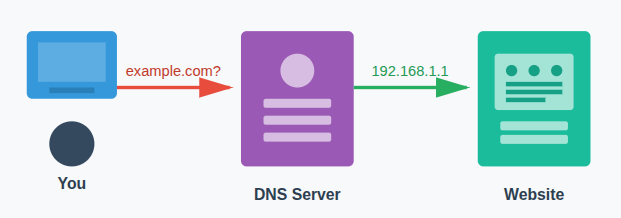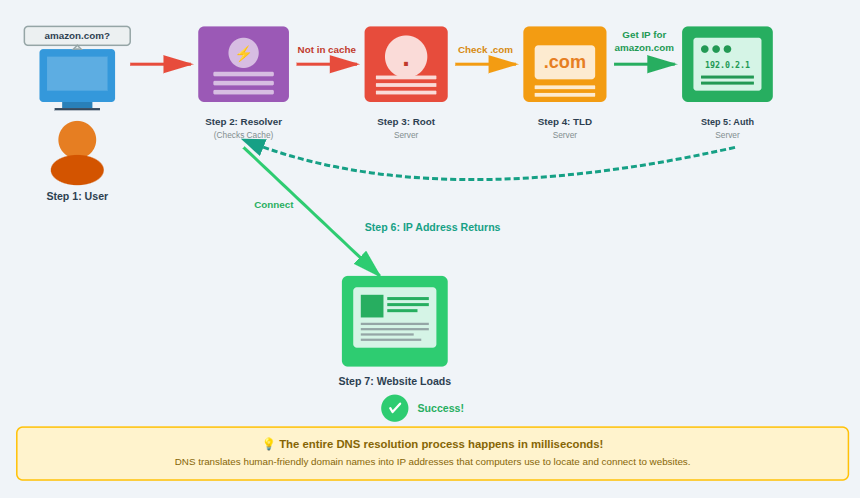
Have you ever wondered how typing something as simple as ‘google.com’ in your browser magically loads a website within seconds? Behind the scenes, a powerful system known as the Domain Name System (DNS) makes it all possible. To truly understand how DNS works, let’s explore the process that translates human-friendly domain names into machine-readable IP addresses that connect you to websites instantly.
DNS works like the phonebook of the internet. Instead of remembering long IP addresses like 142.250.182.206, you just need to simply type a domain name, and DNS translates it into the correct IP address to connect your browser to the right server.
What Is DNS and Why Is It Important?
DNS (Domain Name System) is a system that converts human-friendly domain names into machine-readable IP addresses. Without DNS, you would have to remember numbers instead of names for every website you visit.

The Role of DNS in the Internet World
DNS plays a critical role in making the web user-friendly. It ensures that users can access websites easily, applications can communicate properly, and the internet runs smoothly without interruptions.
Key Components of DNS
For DNS to work efficiently, several components interact with each other, during the resolution process.
1) DNS Client (Resolver)
A DNS resolver is the first point of contact when your device needs to find the IP address of a website. It is usually provided by your ISP, or a public DNS service like Google (8.8.8.8) or Cloudflare (1.1.1.1). Its job is to receive your DNS request and start the process of finding the correct IP address for the domain you entered.
2) Root Name Servers
Root name servers are at top level in DNS hierarchy. They don’t store website IP addresses, but act as a guide. When the resolver doesn’t know where to find the domain, the root server directs it to the correct Top-Level Domain (TLD) server (like .com, .net, or .org).
3) TLD Name Servers
TLD servers manage information for specific domain extensions such as .com, .net, .org, .in, etc. When contacted, they don’t give the final IP, but point the resolver to the correct authoritative name server responsible for the domain.
4) Authoritative Name Servers
These servers hold the actual DNS records of a domain. They provide the final answer, the correct IP address of the website, which is then sent back to the user’s browser to load the site.
5) DNS Records and Their Types:
DNS records are like instructions stored on authoritative servers that tell the DNS how a domain should function. The key record types include:
- A Record: This record links a domain name to its IPv4 address (e.g., 192.168.1.1). It tells browsers, which server to connect to when someone types your domain.
- AAAA Record: Similar to the A record, but it maps a domain to an IPv6 address (e.g., 2001:db8::1). It supports the newer, longer IP format.
- CNAME Record: A CNAME (Canonical Name) record points one domain name to another domain name. It’s often used for subdomains, for example, pointing blog.example.com to example.com.
- MX Record: The MX (Mail Exchange) record specifies which mail server should handle emails for a domain. Without it, email services won’t know where to deliver your messages.
- TXT Record: A TXT record stores text-based information. It’s commonly used for verification and security, such as SPF, DKIM, and Google site ownership verification.
- NS Record: This record shows, which name servers are authoritative for a domain, meaning they hold the actual DNS records and answer DNS queries for that domain.

How DNS Resolution Works (Step-by-Step)
Let’s break down DNS resolution into simple steps.
Step 1: User Enters a Domain Name
When you type any domain, for example, ‘amazon.com’ into your browser, it sends a request to a DNS resolver to find the website’s IP address.
Step 2: DNS Recursive Resolver Checks Cache
The resolver first checks its cache to see if it already has the IP address stored. If found, it returns the result immediately.
Step 3: Query to Root Name Server
If the IP isn’t cached, the resolver contacts a root name server. The root server doesn’t know the exact IP, but directs the resolver to the correct TLD server (e.g., .com).
Step 4: Query to TLD Name Server
The resolver then reaches out to the TLD server for the domain extension. The .com TLD server helps locate the authoritative DNS server for ‘amazon.com’.
Step 5: Query to Authoritative DNS Server
The authoritative server holds the domain’s DNS records and provides the correct IP address for the website.
Step 6: Returning the Final IP Address to the Browser
The resolver sends the final IP address back to your browser.
Step 7: Browser Connects to the Web Server
With the IP address, your browser connects to the website’s server and loads the webpage for you.


Recursive vs. Iterative DNS Queries
What Are Recursive Queries?
In recursive queries, the DNS resolver takes full responsibility for finding the IP address and returns the final answer to the user.
What Are Iterative Queries?
Here, the DNS resolver receives partial answers from each server and continues the query process until it finds the final answer.
Key Differences Between Recursive and Iterative Queries
| Aspect | Recursive Query | Iterative Query |
|---|---|---|
| User Experience | Simple and fast for the user; they only receive the final result. | Happens in multiple steps behind the scenes; user still gets the final result. |
| Speed for End User | Generally faster because the resolver handles everything in one go. | Can be slower due to multiple server lookups. |
| Performance Load | Higher load on the recursive resolver server. | Workload is shared among multiple DNS servers. |
| Network Traffic | More network traffic because the resolver contacts multiple servers. | Less traffic for the resolver as each server gives partial information. |
| Caching Impact | Better caching since full results are stored for future queries. | Less effective caching because it mostly receives referrals. |
| Implementation Usage | Used by ISPs and public DNS servers to fully resolve user queries. | Mostly used between DNS servers to guide lookups step-by-step. |
| Query Responsibility | Resolver takes full responsibility for finding the final IP. | Resolver follows referrals and continues querying servers. |
| Server Workload | Heavy workload on recursive DNS servers. | Lighter workload spread across different DNS servers. |
| Security Considerations | Requires stronger security because it handles full resolutions. | Lower risk since no single server handles the full resolution. |
| DNS Resolution Path | Client sends one query → resolver completes full lookup. | Resolver must query multiple servers sequentially. |
| Common Use Case | Used in consumer-level DNS queries (e.g., Google DNS, Cloudflare DNS). | Used mainly in server-to-server communication within the DNS hierarchy. |
DNS Caching Explained
DNS caching helps speed up the process of finding a website’s IP address by storing previous lookup results temporarily.
What Is DNS Cache?
It’s a temporary record that saves the IP address of a domain you’ve already visited, so your device doesn’t have to look it up again.
Browser Cache
Your web browser stores DNS information for recently visited websites, allowing them to load faster the next time you visit.
OS-Level Cache
Your computer’s operating system keeps its own DNS cache to avoid repeating lookups for the same domain.
Recursive Resolver Cache
Public DNS servers like Google (8.8.8.8) or Cloudflare (1.1.1.1) also store frequently requested domain information to speed up future requests for all users.
TTL (Time-to-Live)
TTL determines how long a DNS record stays in the cache before it expires and must be refreshed with a new lookup.
Common DNS Issues and Errors
DNS_PROBE_FINISHED_NXDOMAIN
This error appears when the domain cannot be found, usually because the domain doesn’t exist, or there’s a DNS misconfiguration.
DNS Server Not Responding
This occurs when the DNS server you are using is down, unavailable, or unable to process requests.
Slow DNS Resolution
Happens when DNS servers are slow, overloaded, or the request has to travel through multiple distant servers, causing delays in loading websites.
How to Improve DNS Performance
Use Faster DNS Providers
Switch to trusted and high-speed DNS providers, like Cloudflare (1.1.1.1), Google DNS (8.8.8.8), or OpenDNS to reduce lookup time and improve browsing speed.
DNS Load Balancing
Balances traffic across multiple DNS servers to increase reliability and ensure the system stays available even during high traffic.
Use Anycast DNS
Distributes DNS servers across the globe so users connect to the nearest server, resulting in faster response times.
DNSSEC for Security
Adds a layer of security by preventing DNS spoofing and ensuring that DNS responses are authentic.
Reduce TTL for Faster Updates
FAQs
Can I speed up my internet by changing DNS?
Yes, switching to a faster DNS provider can significantly reduce response time.
What is the most commonly used DNS record?
The A record is the most commonly used DNS record as it maps domain names to IPv4 addresses.
How long does DNS propagation take?
It usually takes anywhere from a few minutes to 48 hours, depending on TTL settings.
What is a DNS resolver?
It is a server that receives DNS queries and fetches IP addresses for clients.
Why do some websites load without DNS?
If the IP address was previously cached, the browser may bypass DNS temporarily.
Conclusion
DNS is a vital part of how the internet works. Knowing how DNS functions helps users, developers, and website owners solve DNS problems, enhance website speed, and ensure smooth online experiences.
DNS is a crucial system that ensures internet communication remains seamless, user-friendly, and efficient. From translating domain names into IP addresses to caching and load balancing, DNS handles massive amounts of traffic behind the scenes. With this understanding, you can now troubleshoot problems, optimize DNS performance, and appreciate how this invisible system powers the web.
Lowering the TTL value helps DNS changes propagate faster, making updates reflect sooner across the internet.
Stop Wasting Time on Servers. Start Building Instead.
You didn’t start your project to babysit servers. Let ServerAvatar handle deployment, monitoring, and backups — so you can focus on growth.
Deploy WordPress, Laravel, N8N, and more in minutes. No DevOps required. No command line. No stress.
Trusted by 10,000+ developers and growing.
